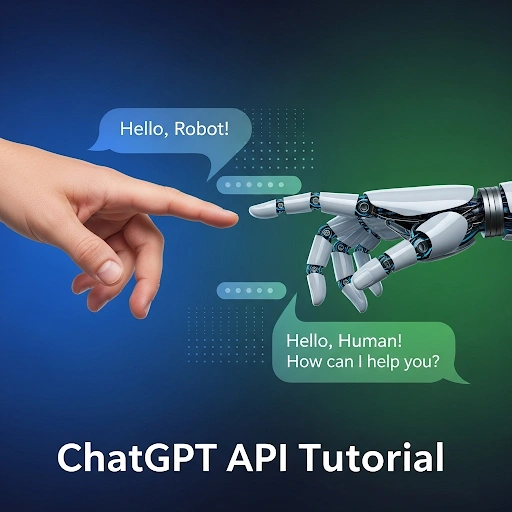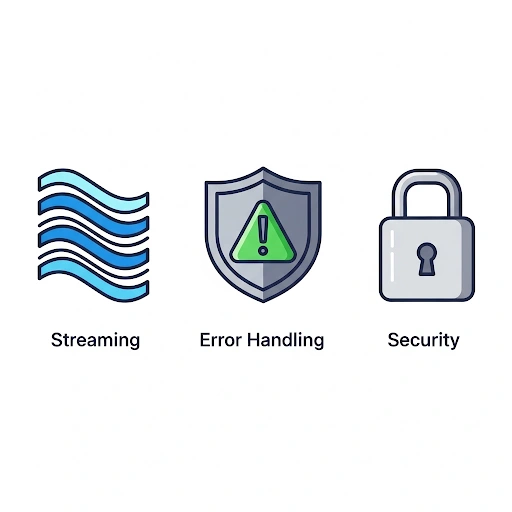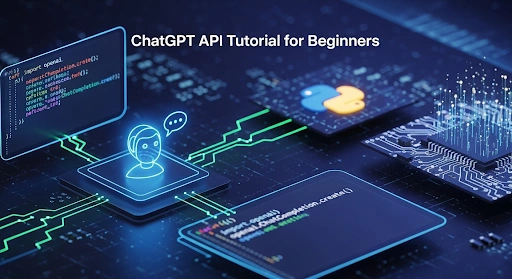Unlock the power of conversational AI. This chatgpt api tutorial breaks down everything you need to know to build a smart, responsive chatbot without requiring expert knowledge. By following a beginner-friendly chatgpt api tutorial, you’ll see how simple tools can turn complex ideas into working solutions. Each step in this chatgpt api tutorial is designed to save time while sharpening your skills. With the right chatgpt api tutorial, creating powerful chatbots becomes accessible to anyone ready to start.
You’ve chatted with them on websites, seen them in apps, and maybe even used them to brainstorm ideas. AI chatbots are everywhere, transforming how businesses interact with customers and how we access information. It’s easy to assume that creating one requires a team of PhDs and a massive server farm. But what if you could build your own powerful, intelligent chatbot with just a few lines of code? Thanks to the power of large language models, this is no longer science fiction.
- What is an AI Chatbot, Really? A Beginner’s Guide with ChatGPT API Tutorial
- Why Building a Chatbot is a Superpower in 2025
- How the ChatGPT API Works: A Simple Analogy
- Let’s Build It: A Simple Python Chatbot
- Common Mistakes for Beginners to Avoid
- Expert Tips for Building a Better Chatbot
- Frequently Asked Questions (FAQ)
- Conclusion: You Are Now a Chatbot Creator
What is an AI Chatbot, Really? A Beginner’s Guide with ChatGPT API Tutorial
At its heart, an AI chatbot is a program built to simulate human conversation through text or voice. A chatgpt api tutorial often shows how this works in practice. Early chatbots were rule-based, responding only to fixed keywords — a limitation many chatgpt api tutorials highlight. If you’ve met a customer service bot that keeps saying “I don’t understand,” that’s the kind of issue a clear chatgpt api tutorial helps solve. With the right chatgpt api tutorial, it’s easier to see how rigid bots evolved into smarter AI assistants.
Modern AI chatbots, powered by Large Language Models (LLMs) like OpenAI’s GPT series, are a different species entirely, and many chatgpt api tutorial guides explain why. They don’t rely on rigid rules; instead, as shown in a practical chatgpt api tutorial, these systems learn from vast text and data to grasp context, nuance, and intent. They can answer complex questions, write creative text, summarize documents, or even generate code, which is why a step-by-step chatgpt api tutorial is so valuable. When you follow a chatgpt api tutorial to build your own bot, you’re essentially connecting the immense power of this pre-trained “brain” directly into your application.

Why Building a Chatbot is a Superpower in 2025
Learning to integrate conversational AI into your projects is more than just a technical exercise; it’s a strategic advantage in almost any field.
Revolutionize Customer Engagement
For businesses, an AI chatbot can provide 24/7 customer support, answer frequently asked questions instantly, and even guide users through a sales process. This frees up human agents to handle more complex issues, improving both customer satisfaction and operational efficiency.
Create Innovative Products and Services
The possibilities are endless. You could build a personalized learning tutor, a creative writing assistant, a tool that summarizes legal documents, or an interactive travel guide. By understanding the API, you can brainstorm and prototype new ideas that were previously impossible for a solo creator or small team.
Gain a Highly Valuable Technical Skill
The ability to work with AI and APIs is one of the most in-demand skills in the tech industry. Learning how to build a chatbot is a practical, project-based way to understand how to interact with powerful, cloud-based services. This skill is transferable to countless other applications and platforms, as discussed in our guide to professional development and skills.
How the ChatGPT API Works: A Simple Analogy
API stands for Application Programming Interface. It’s a scary-sounding term for a very simple concept. Think of the ChatGPT model as a brilliant, all-knowing chef in a huge kitchen (OpenAI’s servers). You can’t go into the kitchen yourself, but you can send a waiter (the API) with your order (your prompt). The chef prepares the dish (the response) and the waiter brings it back to your table (your application).
The Key Components of an API Call
When you send a request to the API, you’re essentially sending a packet of information. The most important parts are:
- The Endpoint: The specific URL (web address) of the API you’re sending your request to.
- The Headers: These contain metadata, most importantly your secret API Key, which authenticates you and tells OpenAI who is making the request.
- The Body: This contains the actual data for your request, including the model you want to use (e.g., `gpt-4o`) and the messages (your prompt and the conversation history).

The Concept of “Prompt Engineering”
The quality of your chatbot’s responses depends heavily on the quality of your prompts. Prompt engineering is the art and science of crafting prompts that get the best possible results from the model. This includes giving the model a clear “role” (e.g., “You are a friendly and helpful customer support assistant”), providing context, and giving examples of the desired output format.
Let’s Build It: A Simple Python Chatbot
Now, let’s get our hands dirty. We’ll build a simple command-line chatbot using Python. This is the foundational logic you could later integrate into a website or a mobile app.
1. Prerequisites
- Python Installed: Make sure you have Python installed on your computer.
- An OpenAI API Key: You’ll need to sign up on the OpenAI Platform and get your secret API key. Keep it safe!
- The OpenAI Python Library: You’ll install this with a simple command in your terminal:
pip install openai.
2. The Python Code
This script will take your input, send it to the ChatGPT API, and print the response. The comments explain what each part of the code does.
# Import the OpenAI library
from openai import OpenAI
# Create an OpenAI client with your API key
# It's best practice to store your key as an environment variable
client = OpenAI(api_key="YOUR_API_KEY_HERE")
# This list will store the conversation history
messages = [
# Set the initial "system" prompt to define the chatbot's personality
{"role": "system", "content": "You are a helpful assistant."}
]
print("Chatbot initialized! Type 'quit' to exit.")
# Start a loop to keep the conversation going
while True:
# Get user input from the command line
user_input = input("You: ")
# Check if the user wants to quit
if user_input.lower() == "quit":
break
# Add the user's message to the conversation history
messages.append({"role": "user", "content": user_input})
# Make the API call to OpenAI
response = client.chat.completions.create(
model="gpt-4o", # Specify the model to use
messages=messages
)
# Get the chatbot's reply from the response
bot_message = response.choices[0].message.content
# Add the chatbot's reply to the conversation history
messages.append({"role": "assistant", "content": bot_message})
# Print the chatbot's reply
print(f"Bot: {bot_message}")
Common Mistakes for Beginners to Avoid
1. Exposing Your API Key
Never, ever paste your secret API key directly into code that you share publicly (like on GitHub). This is like posting your credit card number online. Learn to use environment variables to keep your keys safe.
2. Forgetting to Manage Conversation History
The API is stateless; it doesn’t remember past turns of the conversation unless you send the entire history with each request. Our example code does this by appending messages to a list. Forgetting this will result in a chatbot with no memory.
3. Ignoring API Costs
Using the API is not free. You pay based on the amount of text you send and receive (measured in “tokens”). While it’s very cheap for development, be mindful of your usage and set spending limits in your OpenAI account to avoid surprises.
Expert Tips for Building a Better Chatbot
- Craft a Detailed System Prompt: The initial “system” message is your most powerful tool. Be specific about the chatbot’s role, personality, what it should and should not do, and the format of its responses.
- Implement Streaming: For a better user experience, you can “stream” the response from the API. This displays the text word-by-word as it’s generated, just like in the ChatGPT interface, instead of waiting for the full response to be complete.
- Add Error Handling: What happens if the API is down or your internet connection fails? Good code anticipates these problems and handles them gracefully (e.g., by showing an error message to the user) instead of crashing.
- Consider Security and Privacy: Be responsible with user data. Don’t send personally identifiable information (PII) to the API unless necessary, and be transparent with your users about how their data is being used. For more, read about selecting secure tools and platforms.

Frequently Asked Questions (FAQ)
Q: Can I build a chatbot without coding?
A: Yes! There are many no-code platforms (like Voiceflow or Botpress) that allow you to build sophisticated chatbots with a visual, drag-and-drop interface. They often use the ChatGPT API under the hood.
Q: What’s the difference between the ChatGPT website and the API?
A: The website is a ready-to-use product. The API is a service that gives you, the developer, access to the underlying language model so you can build your own custom applications on top of it.
Q: Can I “fine-tune” the model with my own data?
A: Yes, OpenAI offers fine-tuning capabilities. This is an advanced process where you can train the base model on your own dataset to make it an expert in a specific domain (like your company’s product documentation).
